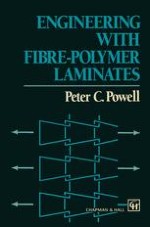1994 | Buch
Über dieses Buch
This book has its recent origins in a Master's course in Polymer Engineering at Manchester. It is a rather extended version of composite mechanics covered in about twenty five hours within a two-week intensive programme on Fibre Polymer Composites which also formed part of the UK Government and Industry-sponsored Integrated Graduate Development Scheme in Polymer Engineering. The material has also been used in other courses, and in teaching to students of engineering and of polymer technology both in the UK and in mainland Europe. There are already many books describing the analysis of and mechanical behaviour of polymer/fibre composites, so why write another? Most of these excellent books appear to be aimed at readers who already have a substantial understanding of stress analysis for linear elastic isotropic materials, who are thoroughly at home with mathematical analysis, and who seem often not to need much of the reassurance which numerical examples and illustrated applications can offer. In teaching the mechanics of composites to many groups of scientists, technologists and engineers, I have found that most of them need and seek an introduction before consulting the advanced texts. This book is intended to fill the gap. Throughout this text is interspersed a substantial range of examples to bring out the practical implications of the basic principles, and a wide range of problems (with outline solutions) to test the reader and extend understanding.
Anzeige
